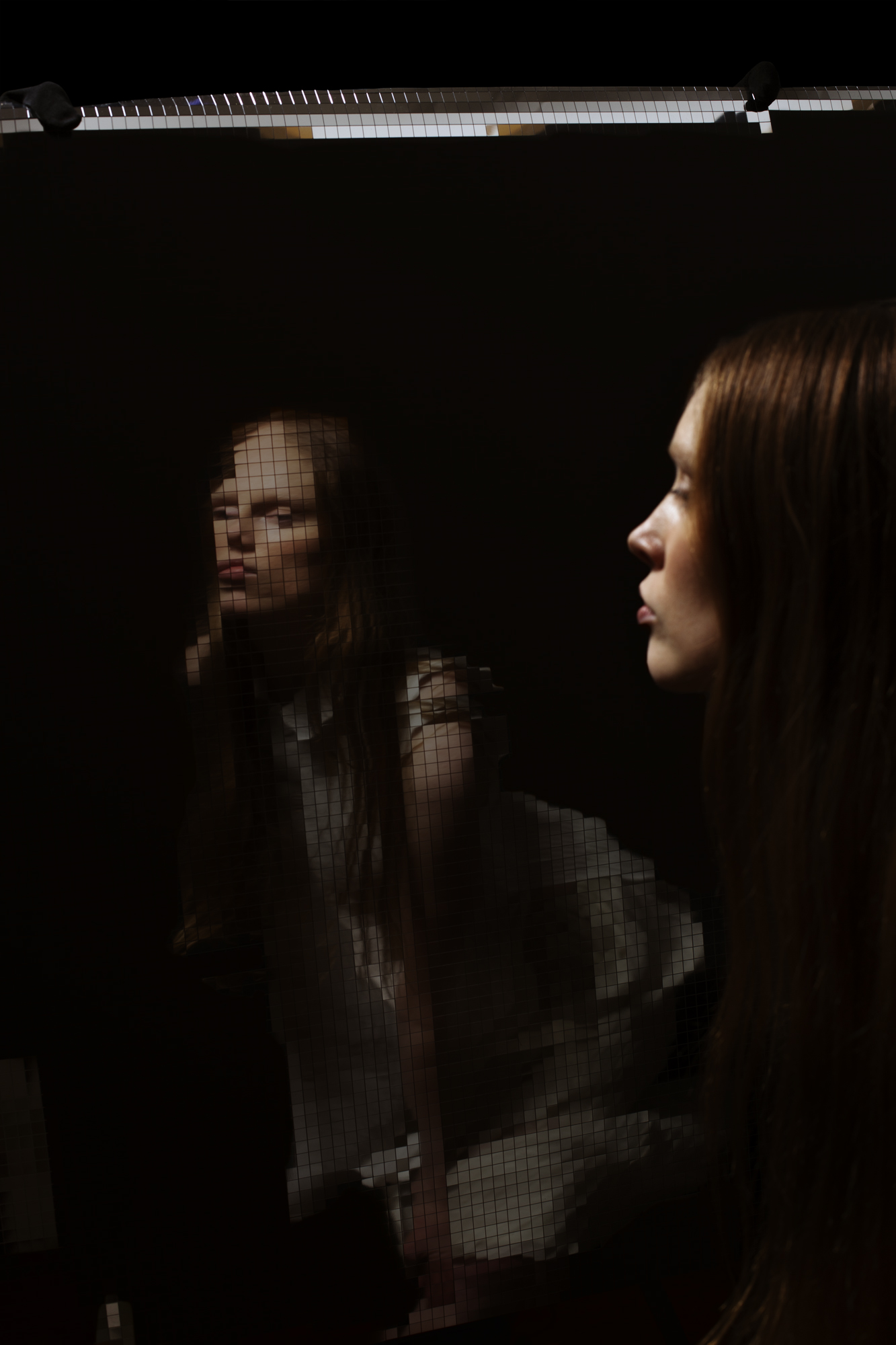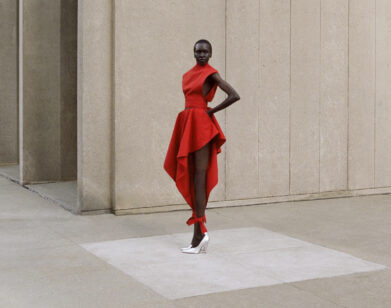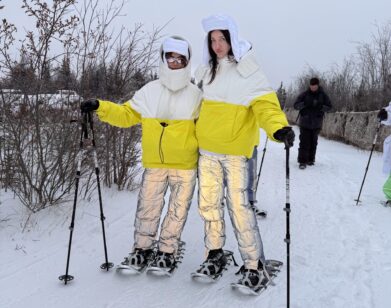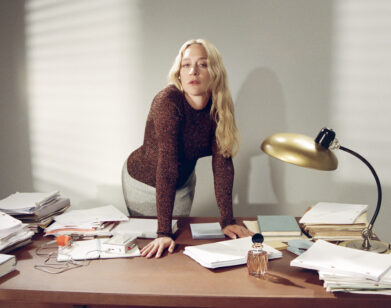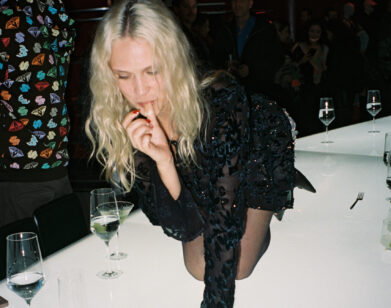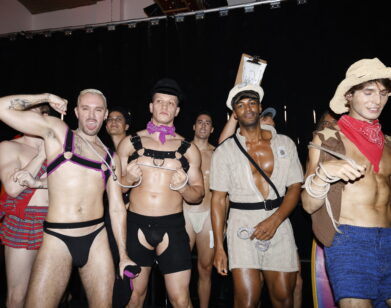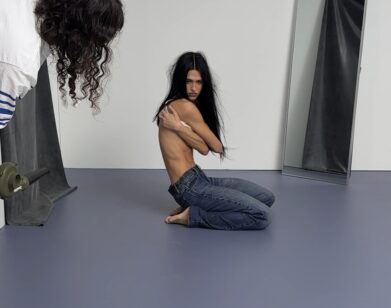Glenn Martens’ Fall 2013 Collection is for the Kids
Bruges-born designer Glenn Martens lives and works in Paris’s 20th arrondissement. After stints in menswear with Jean-Paul Gaultier, and later on with fellow Belgian Bruno Pieters on his Weekdays collection for the H&M Group, the 29-year-old took the plunge and launched his own label. The clothes are a subtly tailored a mix of street shapes and heavenly robes, expert tailoring and romantic flow.
Interview phoned Glenn Martins on the eve of today’s presentation, his third.
REBECCA VOIGHT: This is your third season, and a pattern is beginning to emerge: A taste for Flemish Primitives (Hans Memling, Jan Van Eyck), a mix of rough and rarefied fabrics, earthy shades, architectural covered-up shapes, and fractured image prints. Which of these will appear into the Fall/Winter collection?
GLENN MARTENS: When you launch, you have the luxury of time. I was thinking about this label for years, dissecting my aesthetics, developing the overall mood of what I wished to present before taking the actual step of putting a first collection together. I’m very happy with the atmospheres and codes I have managed to create. I have the urge to keep exploring this world. I see this third season as a continuation of a beautiful story.
VOIGHT: But you’ve moved on a bit from your Flemish Primitive start?
MARTENS: Medieval art will always be a guideline for me. I’ve got a classic vibe, but I’ve moved away from the dark side this season. It’s all less direct and softer, even though the shapes in this collection are still quite strong and pure.
VOIGHT: You’ve said that you can find beauty in anything—tell me about some of the unexpected places you encountered beauty this season?
MARTENS: Anything, really. I think I developed this state of perception in Belgium. My country is actually one huge village. Our rich industrial past didn’t leave much space for nature. You might say it’s ugly and gray—I find beauty in this surreal, nostalgic mood. I project this kind of observation on anything I find in everyday life; the strangest, ugliest places can become invigorating and ultimately beautiful. For example, I don’t mind taking the Paris Métro anymore. I love having a cheap beer in the dodgiest bar.
VOIGHT: And how does this lovely ugliness translate into the clothes this season?
MARTENS: It’s in the way I play with materials. I’m using bright white silk velvet, which looks a bit like a hairy sweater, or a mid-’80s jogging suit. This takes the form of a super-long white skirt and oversized pieces with roll-up cuffs. Even though they’re in silk, the context for these pieces is still the kind of mid-’80s jogging suit every Belgian child was forced to wear by their parents. When I was a child, my mother made me wear these little shorts which looked like they were glued to my ass. A kid could get arrested wearing those! So, I wanted to make a version that’s completely different. Mine has the jogging vibe, but it’s more like eveningwear.
VOIGHT: This sounds like generations of American kids in the 1950s, ’60s and ’70s who were dressed by their style-blind suburban moms in Sears catalog staples. Was there a theme for this collection?
MARTENS: There’s a story. I like to start from a mood, something more psychological than graphic. This collection is about kids, freed from standards, principles, and values. They don’t care and have no interest in tomorrow. It’s all about how this generation—which grew up too fast and got “lost” in all the excitement with their first taste of independence and freedom colored by an overdose of rebellion, parties, drugs, and anarchy—eventually comes of age. They’re “lost” until the day they bump into their “adult,” a person who does not have a grip on them by authority or restriction. This “adult” ultimately inspires through their lifestyle, passion, interest, and intellect. The child’s encounter with this person is the trigger; it opens the door to adulthood helping to reaffirm one’s responsibilities. So, the collection is about both the youngster and her role model at the time of their first meeting. It’s about how the role model once used to be a lost kid themselves, and still carries the wildness of her past inside her. And how the kid looks up to the role model who will figure as the one strong point of the kid’s future checkered life.
VOIGHT: But what about the clothes! I see streamlined dresses or robe coats in the sketches on your wall—how do they fit in ?
MARTENS: Actually, they’re oversized t-shirts, seen as long dresses. I wanted to refer to what kids wear and translate that for a contemporary woman. Of course, this is all filtered through my world. So there will always be a link to this gothic minimalism. The idea of the t-shirts was to look back at rave culture. So we made long, long, oversized dresses, with an open slit up the back held by a gold buckle. They’re in three different materials: really shiny, ice-blue duchesse satin; stiff modal cotton; and double layered mesh, which gives an optical effect as the holes play against each other.
VOIGHT: That light blue satin looks quite ecclesiastical. So your imagination is still in a gothic church?
MARTENS: They look a bit like priest’s dresses.
VOIGHT: I know you like bomber jackets—what about this fall?
MARTENS: There’s no real bomber jacket this season, but the vibe is still there… projected on long coats and tops.
VOIGHT: You also like turtlenecks—do they make an appearance?
MARTENS: I love a women’s neck. It guides your eye to her smile. I like the fact that a turtleneck keeps this graphic look while still protecting her from the winter cold.
VOIGHT: What about box pleats and paneled column constructions? You seem to fit them in throughout your design.
MARTENS: I love experimenting with construction; pleats and panels are a great medium for that. There’s always the possibility of layering and hiding things with pleats. They can create a screen, which hides more revealing construction underneath. There’s this one skirt in my Fall/Winter collection, shaped with just a few folds. When you see it from the side, it looks like a long, heavy skirt, but when the woman walks, there are these really high slits that pop out from under all those layers. I mean, you have to really open the skirt to see the slits. So, if the woman wants to, she can really show off her legs. It’s not something that happens on its own—it’s the women in the skirt who decides what she wants to show. I like this kind of sexiness that’s not too “in your face.” For me, pleats give a vertical structure, they elongate the silhouette and elevate a woman. They’re also very comfortable and easy to wear.
VOIGHT: What was your soundtrack while you were putting this collection together?
MARTENS: My playlist is always a mix of styles. There will always be some Marin Marais or Haendel, but then I also like punk-electro bands like Light Asylum, Blonde Redhead, or Cake.
VOIGHT: And the prints? Last season you took Flemish Primitive paintings of dresses and turned them into prints. And you made prints from Toby de Silva photographs of skulls and jewels. How do prints appear this season?
MARTENS: The lovely thing about winter is that you have a broad selection of beautifully woven heavy fabrics to play with. I see this game of texture as my winter print.

